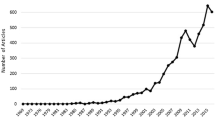Abstract
Between 1950 and 1980 surveys of academic sociologists revealed a major shift in the relative ratings of the top six Sociology departments. Wisconsin rose from a distant sixth to being rated first or second. Harvard and Columbia dropped from first and second the rankings to as low as sixth seventh. Underlying these trajectories were a variety of historical changes affecting academia and Sociology, particularly in the 1960s. Using complete yearly listings of the faculties of these six top departments I trace the demographic changes that appear to have been instrumental in producing the movement in ratings. In particular, the radical growth and youth of Wisconsin, and the aging of Harvard and Columbia seem to have played an important role.








Similar content being viewed by others
Notes
Adding more departments would have been quite costly for an unfunded project. For five of the departments I had to code catalogs held in their libraries. This required travel to four of them, for two I visited multiple times (I was at Wisconsin). Data for Berkeley was graciously provided by Michael Burawoy to whom I am grateful.
Lowess smoothing was used in all cases.
Because of smoothing, numerical values cited here and below may on occasion appear to differ slightly from those in the relevant figures.
References
Abbott, A. (1998). The causal devolution. Sociological Methods and Research. Vol. 27.
Abbott, A. (1999). Department and discipline: Chicago sociology at 100. University of Chicago Press.
Blasi, A. J. (2005). Diverse histories of American sociology. Brill.
Calhoun, C. J. (2007). Sociology in America: a history. University of Chicago Press.
Cartter, A. M. (1966). An assessment of quality in higher education. Washington D.C.: American Council on Education.
Glenn, D. (2010). An elaborate ranking of doctorate programs makes its long-awaited debut. Chronicle of Higher Education.
Harrison, J. R., & Carroll, G. R. (2005). Culture and demography in organizations. Princeton: Princeton University Press.
Hevenstone, D. (2008). Academic employment networks and departmental prestige. In T. N. Friemel (Ed.), Why context matters: applications of social network analysis. Weissbaden: VS Verlag.
Johnston, B. (1986). Sorokin and parsons at Harvard: institutional conflict and the origin of a hegemonic tradition. Journal of the History of the Behavioral Sciences, 22, 107–127.
Jones, L. V., Gardner, L., & Coggeshall, P. E. (Eds.). (1982). An assessment of research-doctorate programs in the United States: Social & Behavioral Sciences. Washington DC: National Academy Press.
Kenniston, H. (1959). Graduate study in the arts and sciences at the University of Pennsylvania. University of Pannsylvania Press.
Kerr, C. (1991). The great transformation of higher education 1960–1980. SUNY.
Platt, J. (1995). Research methods and the second Chicago School. In G. A. Fine (Ed), A second Chicago School. University of Chicago Press.
Platt, J. (1999). A history of sociological research methods in America, 1920–1960. Cambridge Univ Pr.
Platt, J. (2004). Women's and men's careers in British sociology. The British journal of sociology, 55(2), 187–210.
Platt, J. (2010). Sociology. The history of the social sciences since 1945. R. Backhouse and P. Fontaine, Cambridge Univ Pr.
Stengel, R. (2006). Tracking America’s journey. Time, Oct 23.
Turner, S. P., & Turner, J. H. (1990). The impossible science. (pp. 172–3). Sage.
Author information
Authors and Affiliations
Corresponding author
Additional information
I would like to thank James Younker, in particular for his assistance with graphics and statistics, and also with general advice. Helen Rogers also assisted with some of the data collection.
Rights and permissions
About this article
Cite this article
Marwell, G. Departmental Demography and Reputational Success: The Fall and Rise of Top Sociology Departments 1950–1980. Am Soc 43, 294–309 (2012). https://doi.org/10.1007/s12108-012-9162-5
Published:
Issue Date:
DOI: https://doi.org/10.1007/s12108-012-9162-5




